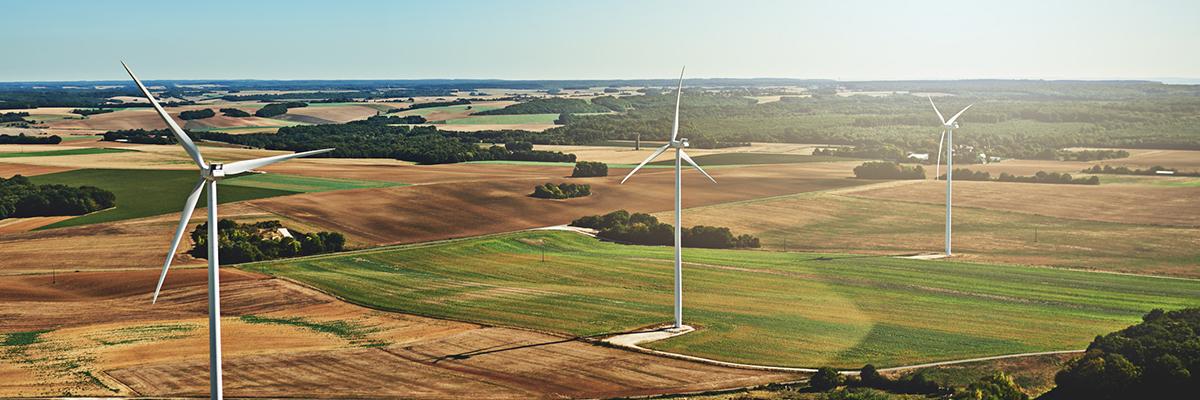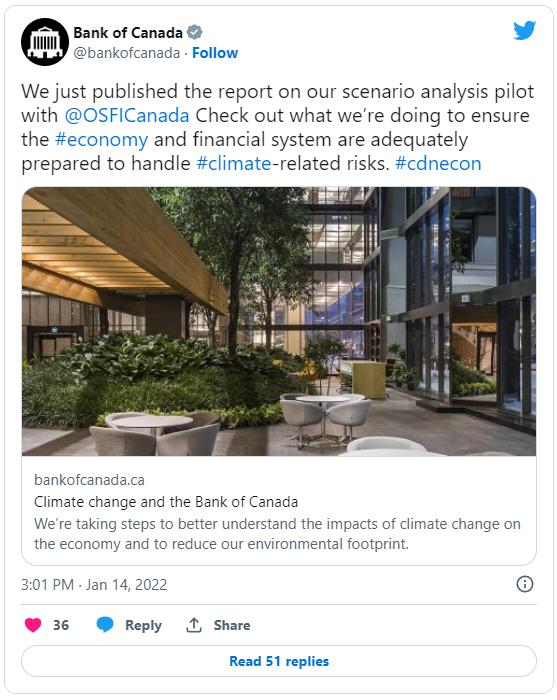
Advancing the Bank of Canada’s climate change work
Climate change and the transition to a low-carbon economy will have profound implications in the decades ahead. In 2022, the Bank of Canada considered these from a variety of angles to help fulfill its monetary policy mandate and foster a stable and efficient financial system. It also continued to work toward reducing its own emissions as well as measuring, mitigating and disclosing its exposure to climate-related risk.
Assessing climate risk to the economy and financial system
Climate change poses significant risks to the financial system and economy. These include economic risks associated with the transition to a low-carbon economy and physical risks due to extreme weather events. In 2022, the Bank furthered its knowledge of what these risks could mean for Canada.
Using scenarios to assess climate-related risks to the financial system
Early in 2022, the Bank helped address some of the uncertainty related to the transition to a low-carbon global economy. Jointly with the Office of the Superintendent of Financial Institutions, it published a report outlining how climate change scenarios could be used to assess the financial sector’s exposure to transition risk.1 This pilot project also helped participating financial institutions improve their ability to assess their own exposure to transition risk and adapt their management practices accordingly.
Building on the success of this initiative, the Bank began new work to gain a clearer picture of how climate risks affect the financial system. The Bank is:
- analyzing the exposure of the real estate sector and mortgage portfolios to flood risks
- enhancing its framework for modelling the macroeconomic effects of the transition to a low-carbon economy
This work will inform future scenario analysis. It will also improve the Bank’s assessment of the systemic risk to the financial system from climate change.
Understanding the economic implications of climate change
Bank staff continued to conduct research to better grasp the impact of climate change on the Canadian economy and inflation.
This included reviewing macroeconomic modelling of approaches to the transition to low carbon and beginning to modify the Bank’s macroeconomic models to better capture the economic impacts of the transition to net-zero emissions. This work will further the Bank’s understanding of:
- the impact of the transition on carbon-intensive sectors (e.g., energy)
- spillover effects to the broader economy
The Bank also began to study how the physical risks posed by climate change are already affecting the Canadian economy. Extreme weather events—such as droughts, floods and wildfires—are becoming more common. The Bank is working to gain a deeper understanding of their economic implications.
Moving the international climate agenda forward
In 2022, the Bank worked with partners to assess climate risks for monetary policy and financial stability. The Bank:
- advocated for international standards that will support globally consistent, comparable and reliable climate-related financial disclosures and encourage the private sector financing needed to achieve a smooth transition to a low-carbon economy
- made a joint commitment with G7 counterparts to further improve their shared understanding of how climate change affects the macroeconomy and inflation2
- actively contributed to multiple work streams of the international Network of Central Banks and Supervisors for Greening the Financial System (NGFS) and, in particular, shared lessons that helped other countries assess and disclose their climate exposures
- hosted two international research conferences where the impact of climate change and the transition to a low-carbon economy were discussed3
Working toward the Bank’s net-zero commitment
The Bank continued efforts to measure and reduce its environmental footprint. This is part of the broader goal of achieving net-zero carbon emissions for Bank operations by 2050. These efforts included completing technical assessments and developing action plans to decarbonize targeted operational areas.
The Bank reached an important milestone in 2022 when it began sourcing 100% of its electricity from providers of renewable energy. It also conducted audits and analyzed processes and data to develop an approach for reporting direct and indirect emissions related to its buildings and business travel. To address its indirect emissions, the Bank started an education and awareness campaign to encourage employees to consider the environmental implications of travel.
With respect to its currency function, the Bank began a process for establishing baseline figures for greenhouse gas emissions, water consumption and waste related to the production and distribution of bank notes. The objective is to identify potential opportunities for improvement in the Bank’s operations and supply chain.
We just published the report on our scenario analysis pilot with @OSFICanada Check out what we’re doing to ensure the #economy and financial system are adequately prepared to handle #climate-related risks. #cdnecon https://t.co/ympd0LvIJi
— Bank of Canada (@bankofcanada) January 14, 2022
Disclosing the Bank’s exposures to climate-related risk
In 2022, the Bank prepared its first annual disclosure of climate-related risks. The report is aligned with the recommendations of the Task Force on Climate-related Financial Disclosures. The report:
- describes the Bank’s governance structure, strategic objectives and risk management approach for climate-related risks
- discloses greenhouse gas emissions and reduction targets related to the Bank’s physical operations
- assesses the carbon intensities and physical risks associated with the asset holdings of the Bank and the Bank’s pension fund
Looking forward
In 2023, the Bank will continue to:
- improve its modelling of the transition path to net-zero emissions, in part by including in its models the growth of renewable energy sectors, more realistic labour market dynamics and uncertainty about future global climate policy actions
- assess the economic and financial system implications of climate risks
- consider whether to incorporate climate change considerations in the Bank’s market operations
- collaborate on climate priorities with G7 counterparts and contribute to the work of the NGFS
- strengthen its ability to measure its climate-related risk exposures, including for the Bank’s financial holdings
- reduce its operational carbon emissions as well as its waste and water footprints
More information
Dashboard on scaling up green finance
NGFS Scenarios for central banks and supervisors
G7 Finance Ministers and Central Bank Governors’ Statement on Climate Issues
- 1. Bank of Canada and Office of the Superintendent of Financial Institutions, “Using Scenario Analysis to Assess Climate Transition Risk: Final Report of the BoC-OSFI Climate Scenario Analysis Pilot” (January 2022).[←]
- 2. In 2022, the G7 finance ministers and central bank governors released their first statement on climate issues, vowing to meet climate goals and accelerate the energy transition while also strengthening energy security.[←]
- 3. The 2022 Annual Bank of Canada Economic Conference was held November 3–4. The New Financial Landscape for Central Banks conference, hosted by the Bank of Canada and the International Journal of Central Banking, took place August 10–11.[←]
